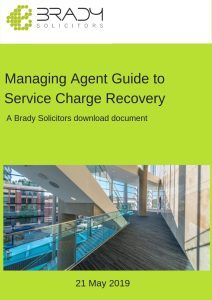An incorrect service charge demand is one of the most common reasons given by leaseholders for non-payment of their service charge contribution.
In this latest Expert View from Brady Solicitors, we remind property managers (old and new!) of the how, when, and where of service charge demands.
Here are our top tips.
1. Read – and understand – the lease
The first step is to check the lease. This is the legal contract that exists between landlord and leaseholder and it will set out (in varying levels of detail) the who, when, what, where, and how you should be making your service charge demands.
The lease will dictate the format of the service charge and will usually prescribe the dates of the service charge period, and how often payments should be made – annually, half-yearly, quarterly, in advance or in arrears.
The lease may state that demands are to be served by first class post or recorded delivery, along with stipulating how the demands are to be addressed.
Get it wrong and you need to be prepared for leaseholders to use it as a valid defence for non-payment. Read your leases and make sure your team understand them.
If you strictly follow the lease and statute/legislation then the demand will be deemed correctly served, and the leaseholder will be contractually liable to pay their service charge.
2. Put it in writing – and beware Beitov!
You must put the service charge demand in writing and, under Section 47 and 48 of the Landlord and Tenant Act 1987, the written demand must include the name and address – in England and Wales – for the landlord and where notices may be served on him by the tenant.
Under Section 30 of the Landlord and Tenant Act 1985, a landlord “includes any person who has the right to enforce payment of a service charge.” This will include RTMs if they are responsible under the lease for collecting service charges.
If a landlord uses a managing agent, the service charge demand must carry the landlord’s name and address and not that of the managing agent.
This crucial point was highlighted in the case of Beitov Properties Ltd v Elliston Martin, where the landlord was unable to recover substantial service charge monies because the address on the demands was ‘care of’ the managing agent, rather than being the address of the landlord.
3. Include the Summary of Rights and Obligations for service charges and administration charges
In England since 1 October 2007, and in Wales since 30 November 2007, it has been mandatory to include a Summary of Rights and Obligations with every service charge demand. Section 21B of the Landlord and Tenant Act 1985 states that this document must be legibly printed or typewritten, with a minimum font size of 10 pts. A faded photocopy may not be sufficient.
Additionally, in Wales, it is mandatory to include a Summary of Rights and Obligations in both Welsh and English with every service charge demand.
If a service charge document is issued without the summary, the leaseholder can lawfully withhold payment.
If your demand includes administration charges, under Section 158 of the Commonhold and Leasehold Reform Act 2002, it is mandatory to include the relevant Summary of Rights and Obligations with every charge.
You can download the Rights and Obligations documents for free from the Resources section of the Brady Solicitors website.
Top tip: There is one set of Rights & Obligations for service charges and one set of Rights & Obligations for administration charges. We recommend printing them as a double-sided document so you don’t make the mistake of including the wrong summary.
4. Serve the demand within the 18 month timeframe
Under Section 20B of the Landlord and Tenant Act 1985, service charge demands have to be made within 18 months of the expense being incurred.
If you miss the 18 month deadline you won’t be able to recover the costs through the service charge, unless you had issued a notice during the 18 months to explain that the costs had been incurred, and that leaseholder contributions will be required.
In summary, to avoid falling foul of the ‘incorrect service charge demand’ excuse, you should:
1. Issue the demand in accordance with the lease
2. Put it in writing, with the landlord’s address in England and Wales
3. Include the Summary of Rights and Obligations
4. Serve the demand within the 18 month time limit
When should I issue the service charge demand?
We recommend that you issue the service charge demand 21 days before payment is due.
A reminder should then be sent to any slow payers 14 to 21 days after the payment due date. This should set out any penalties that may be incurred for further delays in payment.
Is the demand reaching the leaseholder?
Not a legal point as such, but one that is particularly pertinent if you manage blocks with buy-to-let properties. Whilst incorrect demands are a frequent reason for non-payment, the most common reason for a leaseholder not paying their service charge comes down to them not receiving the demand in the first place.
Make sure you have a system in place for keeping track of leaseholder contact details (including email) so you can ensure the service charge demand reaches them.
How to correct an error on a service charge demand
Whilst there are solutions for correcting an invalid service charge demand it is far easier, cheaper and quicker to get your service charge demands right in the first place. Make sure that both you and your team know how, what and when to make service charge demands.


